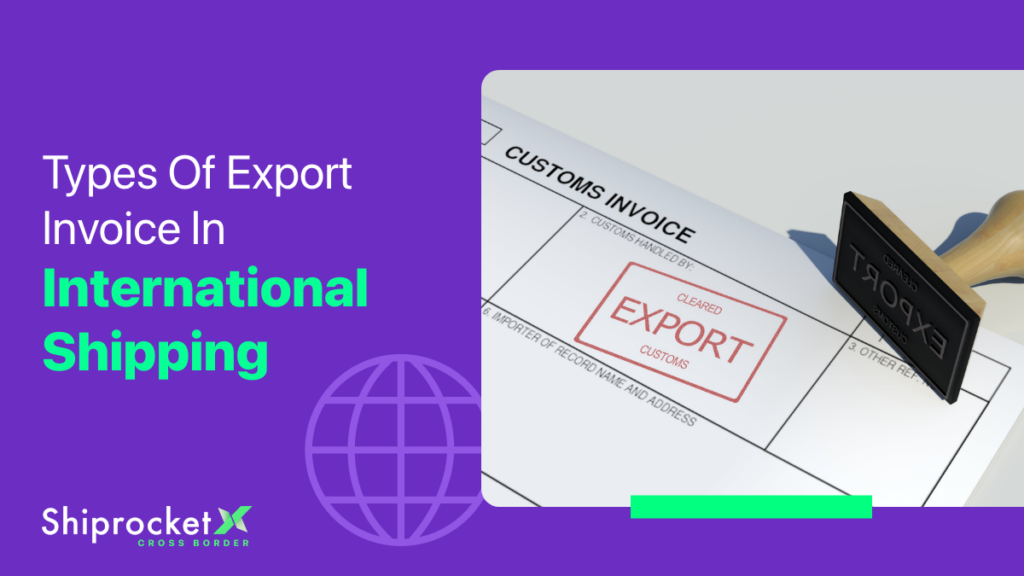Types Of Export Invoices And What To Include In Them
We all know about the nitty-gritty of the Goods and Services Tax (GST) for domestic bills, but what happens when trading overseas? That’s where things get challenging. Exporting goods involves a fair share of paperwork, and at the heart of it all is the export invoice.
An export invoice is the blueprint of an export transaction. It provides crucial information to the buyer, freight forwarder, customs, bank, and other key players in international trade. A simple mistake in your export invoice can lead to problems, delays, and disputes.
To avoid it, let’s dive into the world of export invoices and understand what they’re all about.

What Is An Export Invoice?
An export invoice is a document the seller uses to list the details of the exported goods. It includes the items’ number, size, value, and weight. This document helps government officials calculate customs duties and taxes.
The export invoice also describes the goods and shows the amount due from the buyer. It is similar to a regular tax invoice but includes extra details like exporter and importer information, type of export, and shipping bill.
The export invoice serves several purposes. It lists the items exported, the amount due, and other essential details. It is crucial for insurance claims and acts as proof of the transaction between the exporter and importer. Also, helps the government determine the correct value of the exported items and the applicable taxes.
Why Is An Export Invoice So Important?
An export invoice is a crucial document in the shipping process for several reasons:
- An export invoice proves that a transaction between a buyer and a seller will occur/occurred on a specific date. It acts as a safety net for insurance claims by providing proof of the sale and shipment details. This is crucial if goods are damaged or lost during transportation, as it helps the importer know where to claim insurance.
- The export invoice also shows the legitimacy of the sale between the buyer and seller. It confirms that both parties have agreed to the transaction and details the terms of the sale, including the price, quantity, and description of the goods.
- This document is a vital part of the shipping process. It is one of the primary documents required for shipping goods internationally. Shipping companies and customs authorities would have difficulty processing and approving the shipment without an export invoice.
- Government authorities use the export invoice to determine the value of the shipped goods and calculate the applicable taxes and duties. This is important for ensuring that the correct tax amount is paid and maintaining accurate trade records.
- Importers depend on the export invoice to navigate customs procedures. It helps them ensure the goods clear customs without issues and reach their final destination on time. The invoice provides all necessary information about the shipment, which helps streamline the customs clearance process.
- An export invoice is essential to prevent any difficulties with your shipment. It ensures that all legal and regulatory requirements are met, and it helps confirm that the exporter has paid the correct taxes and duties. This reduces the risk of shipment delays, fines, or other complications.
What Are The Different Types Of Export Invoices?
There are primarily five types of export invoices, each serving its unique purpose:

Commercial Invoice
A commercial invoice is an important export document. It serves as legal proof of a sale between the buyer and the seller. This document helps with customs clearance and calculating duties and taxes. It lists the goods sold, their descriptions, quantities, and the agreed values.
This invoice is also known as a Document of Contents because it provides the information needed to prepare other documents for international trade. There is no standard format for commercial invoices, but it should include the following details:
- Date
- Name and Address of Seller and Customer
- Order Number
- Contract Number
- Proforma Invoice Number
- Quantity and Quality of the Goods
- Terms of Sale
- Port of Shipment and Destination
- Value of the Goods
- Advance Payment Details (if any)
- Shipping Mark or Number on Packages
Consular Invoice
The consular invoice comes into play when you’re exporting to specific countries. It requires certification from the consulate or embassy of the destination country.
This certification provides an official record of the type and value of the goods being transported, along with the merchandise quantity, value, and other vital information, making it easier to establish the duties in the importer’s country. It also streamlines the inspection process in the importing country. The other main reasons for using consular invoices are:
- Facilitate the fixing of duties in the Importer’s country
- Speeds up the inspection process in the Importer’s country
Proforma Invoice
A proforma invoice is a document the seller sends to a potential foreign buyer. It provides clear details about the goods’ type, quality, value, and weight. It also includes transportation charges. The buyer accepts this export invoice and quotation by sending a purchase order.
Once the proforma invoice is accepted, the buyer typically responds by sending a purchase order.
Customs Invoice
Some countries, such as the USA and Canada, require customs and standard commercial invoices. This document must be completed using a template provided by the importing country’s customs office.
The importing country’s customs office provides the format for this invoice to traders. Its purpose is to give information about the import value at the destination port.
The customs invoice contains similar information to the commercial invoice, except it includes additional details like freight, insurance, and packing costs. The main goal is to determine the customs import value at the destination port accurately.
Legalised Invoice
A legalised invoice, while somewhat similar to a consular one, stands out regarding format flexibility. This type of invoice is typically demanded in Middle Eastern countries.
It receives official authorisation, usually through stamping and attestation, from the importer’s country’s consul, located in the exporter’s country. While it doesn’t follow a predetermined format like the consular invoice, it serves a similar purpose of verifying the document’s authenticity for customs clearance.
What Should all be included in an export invoice?
While the exact details can vary from country to country, there’s a must-have checklist for export invoices:
- Supplier Information: Supplier’s Name, contact details, and address, including email and phone numbers for clear identification.
- Buyer Information: Buyer’s Name, address, and contact details to facilitate communication.
- Supplier’s GSTIN: The unique Goods and Services Tax Identification Number assigned to registered taxable persons under the GST Act.
- Details of Goods/Services: Comprehensive information about the goods/services sold, including rates, quantities (for goods), and corresponding amounts.
- Invoice Date: The date the invoice is generated serves as a reference point for the transaction.
- Invoice Number: A unique alphanumeric combination arranged sequentially to track transactions.
- Conversion Rate: Reflecting currency conversion for export transactions, especially for currencies other than the Indian rupee.
- Total Amount: The invoice’s value includes insurance, freight, and taxes.
- Export Type: Indication of whether the export is under a bond, letter of undertaking to a Special Economic Zone (SEZ), or after the payment of Integrated Goods and Services Tax (IGST).
- Shipping Bill Details: Information regarding the shipping bill, including a detailed customs document declaring the type and value of exported goods.
- Signature: Supplier’s physical or digital signature for transaction authentication.
- Any additional remarks or instructions by the supplier to the importer.
- International sales terms (Incoterms) to define responsibilities in the shipping process
- Harmonised Tariff Schedule classification number to facilitate shipping
- Country of origin for customs duties
Elevate Your Business with Shiprocket’s Seamless Shipping Solutions
Shiprocket optimises your shipping process and enhances your online journey. You can access tools designed to streamline operations and boost customer satisfaction by signing up for free.
With Shiprocket, you can easily estimate delivery dates, track orders, and monitor revenue. Join over 5,000 satisfied sellers who trust Shiprocket for their shipping needs. You can easily manage orders and total revenue, and fulfill 3,000 orders monthly. Drive repeat purchases, streamline operations, and use a multi-courier network covering 24,000+ pin codes. Chosen by 250,000 merchants nationwide, Shiprocket streamlines the entire customer journey.
You can simplify domestic shipping by managing all channels in one place and offering fast delivery options. Explore B2B shipping services to save costs or make quick hyperlocal deliveries. You can also ship globally with ShiprocketX, accessing 220+ countries and territories.
Manage everything from sales channels to inventory and carriers. Leverage AI-driven analytics and tailored workflows to optimise your business. Experience Shiprocket today and start your journey to shipping success.
In A Nutshell
Export invoices are essential in international trade. They record the transaction and provide critical details for customs and taxes. Knowing the types of export invoices (commercial, consular, proforma, customs, and legalised) and their contents is crucial for exporters. Including product descriptions, HS codes, incoterms, and currency conversion rates helps avoid delays and ensures smooth exports. Consulting a customs broker or trade expert can help understand different countries’ requirements.
Make sure to differentiate your export invoice from your standard accounting invoice. Avoid customs chaos and potential fines by communicating clearly with your customers about the sales contract and what needs to be included on the invoice.






